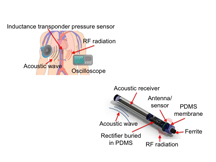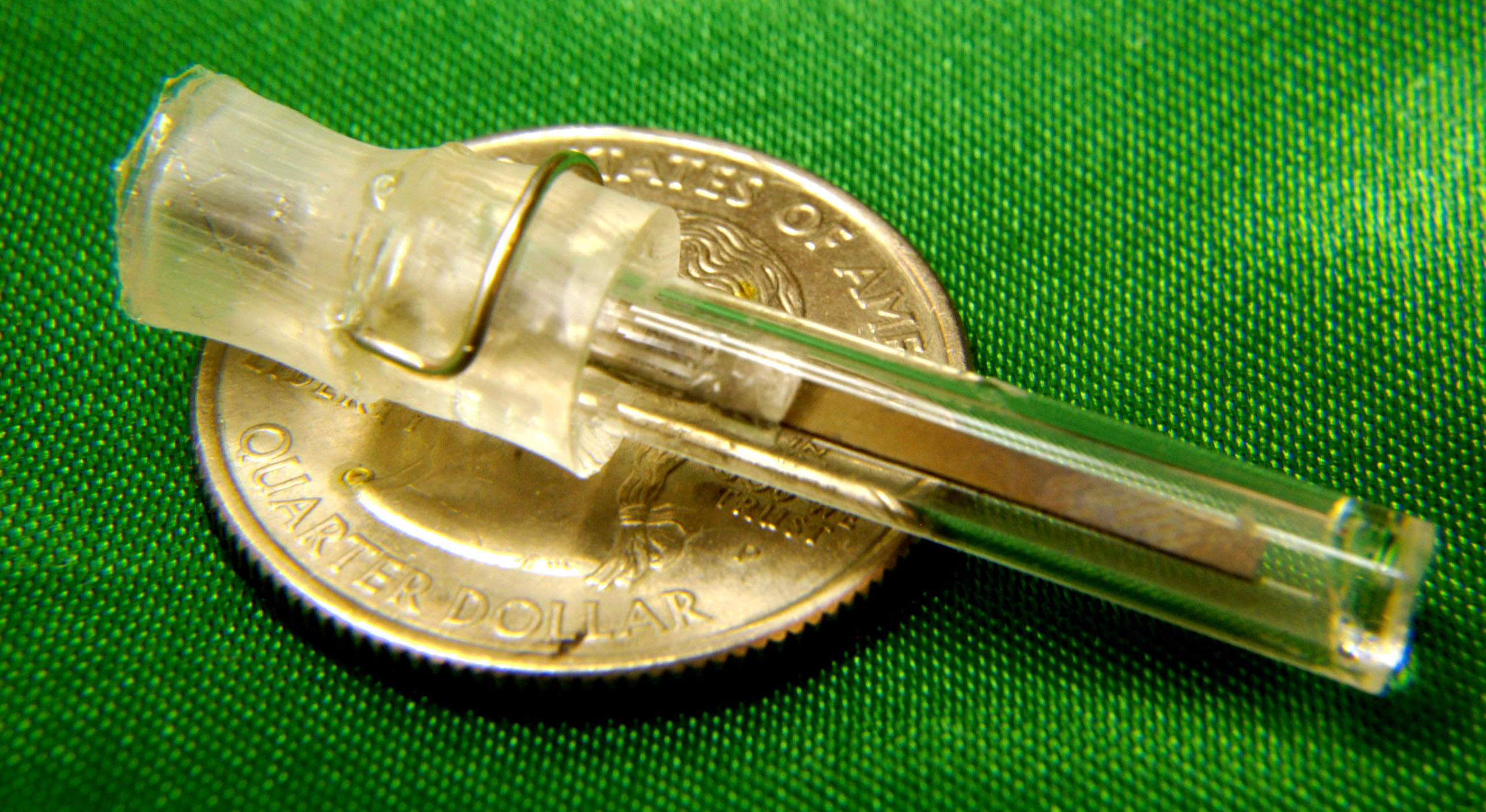What Frequency Is Rap Music
Rap music powers rhythmic action of medical sensor
January 26, 2012

This graphic illustrates the principles behind the operation of a new blazon of miniature medical sensor powered by audio-visual waves, including those found in music such equally rap, blues, jazz and rock. The device, a pressure sensor, might ultimately aid to care for people stricken with aneurisms or incontinence due to paralysis. (Birck Nanotechnology Center, Purdue University)
Download image
Audio-visual waves from music, particularly rap, were found to effectively recharge the pressure sensor. Such a device might ultimately help to care for people stricken with aneurisms or incontinence due to paralysis.
The heart of the sensor is a vibrating cantilever, a thin beam attached at one end similar a miniature diving board. Music within a certain range of frequencies, from 200-500 hertz, causes the cantilever to vibrate, generating electricity and storing a accuse in a capacitor, said Babak Ziaie, a Purdue Academy professor of electric and figurer engineering and biomedical engineering.
"The music reaches the correct frequency only at certain times, for example, when in that location is a strong bass component," he said. "The acoustic free energy from the music can pass through body tissue, causing the cantilever to vibrate."
When the frequency falls outside of the proper range, the cantilever stops vibrating, automatically sending the electrical charge to the sensor, which takes a force per unit area reading and transmits data every bit radio signals. Considering the frequency is continually changing according to the rhythm of a musical composition, the sensor can be induced to repeatedly alternate intervals of storing charge and transmitting data.
"You would just need to exercise this for a couple of minutes every 60 minutes or so to monitor either blood pressure or pressure of urine in the float," Ziaie said. "It doesn't have long to do the measurement."
Findings are detailed in a paper to be presented during the IEEE MEMS conference, which will be January. 29 to Feb. ii in Paris. The newspaper was written past doctoral student Albert Kim, research scientist Teimour Maleki and Ziaie.

Researchers have created a new blazon of miniature pressure level sensor, shown hither, designed to be implanted in the trunk. Audio-visual waves from music or plain tones drive a vibrating device called a cantilever, generating a accuse to ability the sensor. (Birck Nanotechnology Heart, Purdue Academy)
Download prototype
"This paper demonstrates the feasibility of the concept," he said.
The device is an example of a microelectromechanical system, or MEMS, and was created in the Birck Nanotechnology Center at the university'south Discovery Park. The cantilever beam is made from a ceramic material chosen lead zirconate titanate, or PZT, which is piezoelectric, meaning it generates electricity when compressed. The sensor is about two centimeters long. Researchers tested the device in a water-filled balloon.
A receiver that picks up the data from the sensor could exist placed several inches from the patient. Playing tones within a certain frequency range also can be used instead of music.
"But a patently tone is a very annoying sound," Ziaie said. "We idea it would be novel and likewise more aesthetically pleasing to employ music."
Researchers experimented with four types of music: rap, dejection, jazz and stone.
"Rap is the best considering it contains a lot of low frequency sound, notably the bass," Ziaie said.
The sensor is capable of monitoring pressure in the urinary float and in the sack of a blood vessel damaged by an aneurism. Such a technology could be used in a system for treating incontinence in people with paralysis by checking bladder pressure and stimulating the spinal string to close the sphincter that controls urine flow from the float. More immediately, it could be used to diagnose incontinence. The conventional diagnostic method now is to insert a probe with a catheter, which must be in place for several hours while the patient remains at the hospital.
"A wireless implantable device could be inserted and left in place, allowing the patient to go abode while the pressure is monitored," Ziaie said.
The new technology offers potential benefits over conventional implantable devices, which either use batteries or receive power through a belongings called inductance, which uses coils on the device and an external transmitter. Both approaches have downsides. Batteries have to be replaced periodically, and data are hard to retrieve from devices that use inductance; coils on the implanted device and an external receiver must be lined upwardly precisely, and they tin can just be well-nigh a centimeter apart.
A patent application has been filed for the design.
Writer: Emil Venere, 765-494-4709, venere@purdue.edu
Source: Babak Ziaie, 765-494-0725, bziaie@purdue.edu
Note to Journalists : An electronic copy of one of the papers is available from Emil Venere, Purdue News Service, at 765-494-4709, venere@purdue.edu
Abstruse
A Novel Electromechanical Interrogation Scheme for Implantable Passive Transponders
This paper presents design, fabrication and implementation of a novel electromechanical free energy scavenging and wireless interrogation scheme using low-frequency components of musical vibrations to overcome challenges associated with previously reported passive transponders such as: short transmission range, misalignment sensitivity and complicated receiver circuitry. The transponder has ii phases of performance: one) mechanical vibration phase, in which an audio-visual receiver (a piezoelectric cantilever) converts the audio vibration into electric power and charges a capacitor; and 2) electrical radiation stage, in which the stored charge is dumped into an LC tank, forcing it to oscillate at its natural resonance frequency and emitting the free energy to an outside receiver. In a pressure-sensing configuration, the distance between a planar coil and a ferrite cadre is modulated by the pressure level, thus changing the inductance and, in turn, inducing a change in the frequency of the emitted betoken. A prototype transponder was built and tested using a PZT cantilever with a mechanical resonant frequency of 435 Hz encapsulated in a glass capsule (length=40 mm, bore=8 mm) forth with a rectifier circuitry and a storage capacitor. The inductive pressure sensor located exterior the capsule had a sensitivity of 2.5k Hz/kPa. Nosotros were able to easily option upward the transmitted RF pulses at distances of upward to 7 cm without the tight requirement on alignment betwixt the receiver and the transponder coils.
What Frequency Is Rap Music,
Source: https://www.purdue.edu/newsroom/research/2012/120126ZiaieMusic.html
Posted by: martinezwitund.blogspot.com


0 Response to "What Frequency Is Rap Music"
Post a Comment